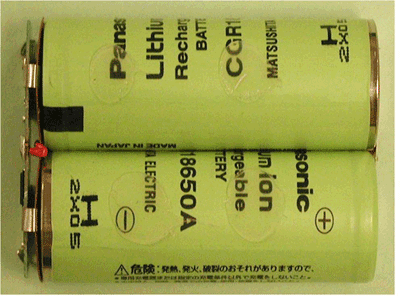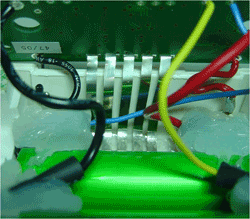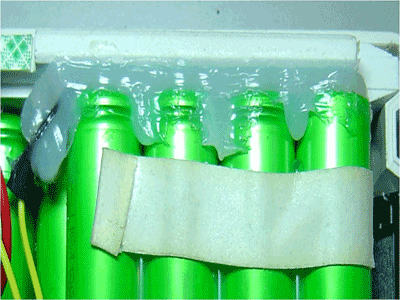Violations include insufficient safety circuitry to poor manufacturing quality
BY JEFF VANZWOL
Micro Power Electronics
Beaverton, OR
http://www.micro-power.com
The continuing growth of portable handheld devices has spawned a healthy selection of aftermarket battery pack suppliers. Both the OEM and end users pay a price when counterfeit battery replacements are chosen. The quantifiable impact of imitation battery packs to the original equipment manufacturer includes increased safety risks for their customers, greater product returns due to non-performing batteries, reduced customer satisfaction, and reduced revenue for batteries supplied by the original manufacturer. In an analysis of several counterfeit batteries, we found safety violations ranging from insufficient safety circuitry to poor manufacturing quality.
Battery pack safety features
Battery packs are no longer a simple configuration of cells. They are carefully engineered products with many safety features. The main components include of a battery pack include; the cells, which are the primary energy source, the printed circuit board, which provides the intelligence of the system with features such as the fuel gauge and protection circuitry, the plastic enclosure, external contacts, and insulation.
The safety features of a battery pack are outlined in great detail in standards from several sources. The most notable are the IEEE 1625 and 1725 standards for lap-top and cell phone batteries, respectively. Guidelines for battery systems include using:
Quality cells from a top tier cell manufacturer A protection or safety circuit provides safe electrical operationQuality manufacturing and good mechanical design Isolation of the Printed Circuit Assembly from the cells Support for the release of vented gassesQuality resistance welds that meet IPC 610 soldering standardsElectrical tests should be applied to every pack design including continuous charge, over-discharge, overcharge, and short-circuit tests.Mechanical tests should be applied to every pack design include shock, vibration, thermal shock, altitude, thermal exposure, and mould stress.
When overstressed, any Li-ion technology can be hazardous to a degree. Extra caution must be exercised during the design process to ensure that the cells are being utilized in a manner appropriate to the technology.
The development of the aftermarket ecosystem
The product life cycle of a portable device in the medical, commercial military and industrial equipment markets often exceeds the cycle life of the product’s battery. In addition, portable devices are becoming more common place and the use models for these devices is becoming more truly mobile and intense as users adjust to the advantages that portability offers. Intense use shortens the number of years of viability of the original battery. The high unit-price of industrial devices, combined with their increasing volumes, opens the market for third party replacement batteries. Aftermarket vendors may compromise the end user experience or safety to make the battery packs inexpensive and attractive to prospective customers. Our analysis of aftermarket battery packs compared them with their OEM counterparts. Many quality issues were observed in the aftermarket battery packs.
Analysis of counterfeit battery packs
There is a large potential for safety hazards due to the manufacturing and design issues found in the aftermarket batteries. It is surprising and troubling that more safety and performance issues were observed in the medical and industrial products, rather than consumer battery products. This goes against intuition, but it is easily explained because these products are produced in lower volume (therefore less automation in production), and the products are more complicated. Our analysis of aftermarket battery packs, revealed the following issues:
Use of substandard or unqualified cells Mismatched components on circuit boards that may not provide adequate performanceLack of a current/voltage or thermal protection circuitLack of accommodation for normal cell swelling over timeNonexistent or obstructed gas ventsBad welds or solder joints
Figures 1 to 4 illustrate some of the poor manufacturing quality issues observed in a selection of counterfeit battery packs.
Bad welds are by far the most commonly observed problem, and they can serve as a warning signal. This image shows an example of problematic welds. Welds such as these should be caught in a next step inspection process and if they are present in a battery pack that goes out to the market it is a strong indication that the manufacturer’s quality processes are not sufficient.

Fig. 1. Terminals standing out from the enclosure.
Connector design is another place where insufficient quality is often observed, as seen in this image. This image shows the battery terminals standing out from the enclosure. The contacts could also be misaligned in the enclosure housing. This could be an extremely dangerous condition as the pack can be shorted out if placed against a conductive surface, such as a metal work top, or intermittent contact with the host device could lead to interrupted device operation.

Fig. 2. No insulation was used between these cells.
A small amount of separation should be included in the form of a polymeric shock absorbing material between the cells. During periods of vibration or shock, the shrink wrap insulation around the cells can be damaged and expose the cells to an increased likelihood of shorting or mechanical damage. This image shows an aftermarket battery where the cells are not separated at all.

Fig. 3. These metal strips should be insulated.
Any bare, loose conductor is a potential hazard and a sharp bare piece of metal is especially troublesome. In a properly manufactured battery, the Nickel strips should separated and insulated to prevent shorts between strips and prevent cutting the insulation on the nearby wires. The strips in a counterfeit pack are completely bare. These strips are long and wrap around so the concern is increased. They could touch one another or cut into other insulation.

Fig. 4. Excess silicone insulation can block safety vents.
Finally, we see a very serious manufacturing issue for this rechargeable Li-ion battery pack. It is important to use Silicone insulation sparingly if at all. Excess Silicone can block cell vents – one of the primary safety features provided by the cell manufacturer. Trapped gas increases explosive risks. If one of the cells goes into thermal runaway, the gases could be trapped and build up pressure. This is a very serious safety issue for the user. Frame holders or foam are much better alternatives to silicone because they are more easily managed during manufacturing and will not block vent holes in the pack or cells.
How to protect your products
It is important to protect yourself as a consumer against the dangers of knock-off battery packs and, as an electronic design engineer, it is your responsibility to protect your company from the aftermarket packs as well. There are many options available to design in protection against aftermarket batteries. The most obvious is the form of the packaging and connectors, but this approach can be circumvented by simple measurements, and once a counterfeit or clone is available the original manufacturer would have to change the form factor, a non-trivial task. Labeling, such as stickers, certification markings, & holograms are another possibility, but good quality, cheap, scanners and color copiers make these methods easy to reproduce. Web based registration is another idea, but it creates an inconvenience for the user. The design engineer’s objective is to increase the pain level of an unauthorized manufacturer so that they choose not to manufacture a clone of the battery pack. An electronic challenge and response or electronic identification (ID) may be warranted for the protection of the OEM’s product; the added cost of an ID based solution may be sufficient to achieve the goal of increasing the time and expense to create counterfeits.
It is important that the design community does not neglect the danger of counterfeit batteries. Imitation or aftermarket batteries have resulted in public relation issues for portable equipment manufacturers because these counterfeits are usually of lower quality than the original battery. While protection of business is a side effect of adding authentication, the main benefit to OEMs comes from the protection of their corporate names and reputations. The intangible qualitative impact negative affect on the device manufacturer’s brand name equity cannot be underestimated since safety and performance are both compromised in the production of aftermarket battery packs. ■d
Advertisement
Learn more about Micro Power Electronics





